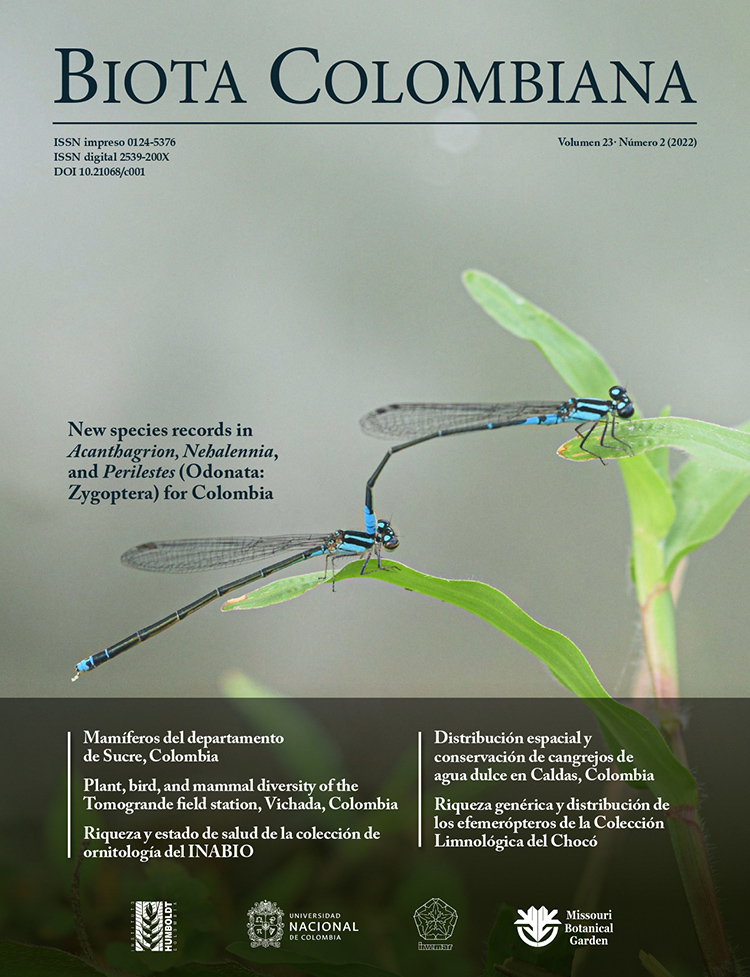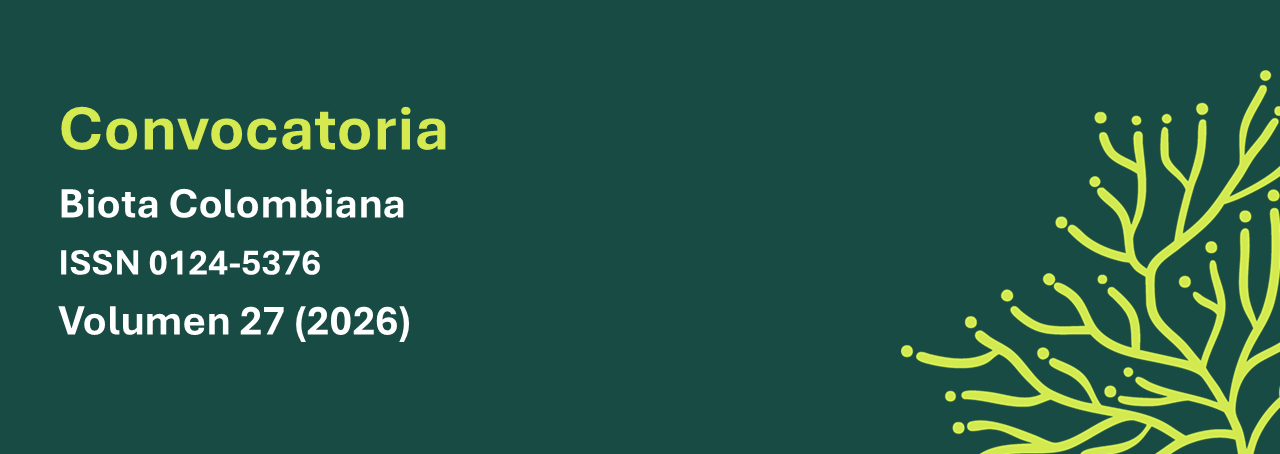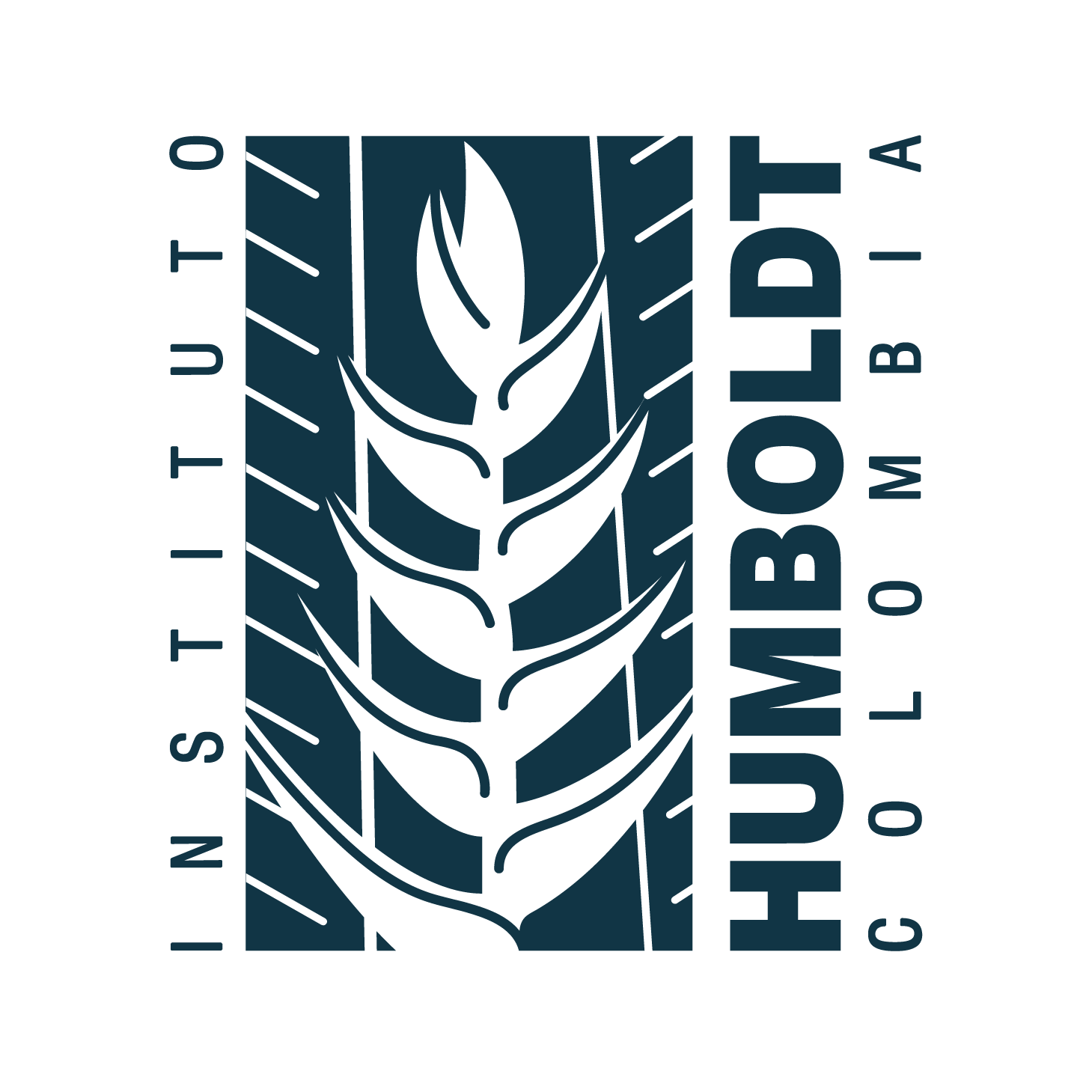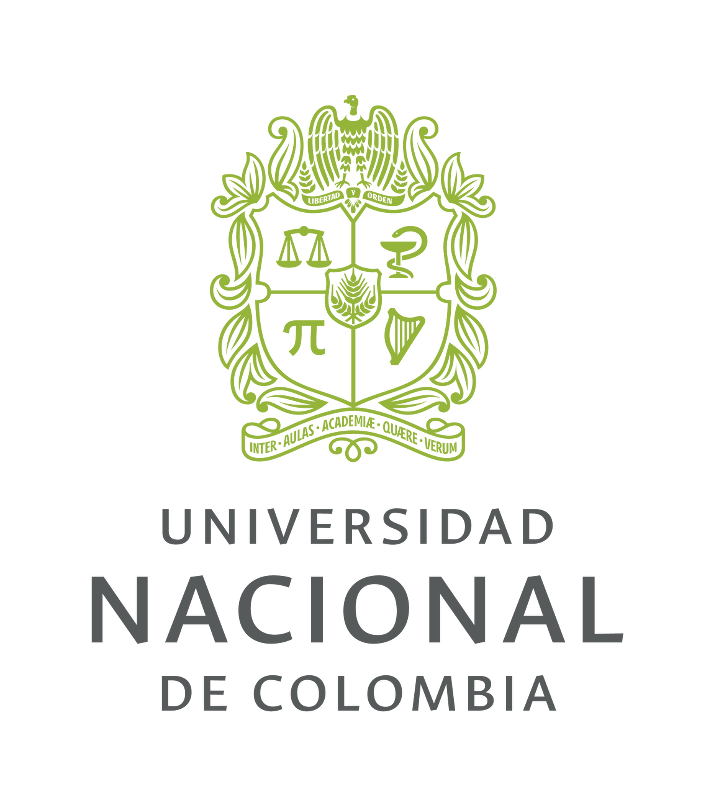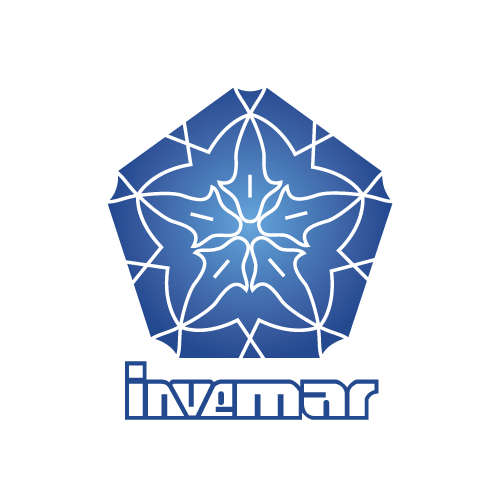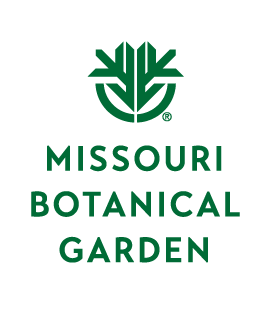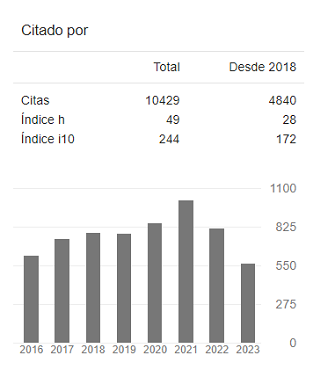Resumen (es):
La Altillanura es un ecosistema único de los Llanos colombianos, caracterizado por sabanas bien drenadas y grandes extensiones de bosques ribereños. La Altillanura alberga ricas comunidades poco estudiadas y actualmente amenazadas por la agroindustria a gran escala y no planificada. Además, el número de áreas protegidas públicas en la Altillanura no es suficiente para conservar los hábitats y especies amenazados. Por lo tanto, los esfuerzos de las reservas privadas son cruciales para la conservación de la biodiversidad de la región. Presentamos el primer listado de especies del Tomogrande, reserva natural privada y estación de investigación científica en el municipio de Santa Rosalía, Vichada, Colombia. Después de diez años de investigación en curso, hemos registrado 299 especies de plantas, 189 especies de aves y 47 especies de mamíferos. En comparación con otras reservas naturales privadas en Vichada y con el Parque Nacional Tuparro, el área protegida más grande de la región, Tomogrande hace una contribución sustancial a la conservación de los tres grupos taxonómicos. Abogamos por una mejor planificación del paisaje y que prácticas sostenibles sean obligatorias en la Altillanura, a fin de proteger su biodiversidad y los medios de vida de todos los actores que habitan esta región.
Resumen (en):
The Altillanura is a unique ecosystem within the Colombian Llanos, characterized by well-drained savannas and extensive riparian forests. The Altillanura harbors a rich assemblage of species, largely understudied and currently under threat by large-scale and unplanned agribusiness. Moreover, the number of public protected areas in the Colombian Llanos, particularly in the Altillanura, is insufficient to conserve the threatened habitats and species. Therefore, conservation efforts by private reserves are crucial for the protection of the region’s biodiversity. Here we present the first species list of the Tomogrande, a private nature reserve and scientific research field station in the municipality of Santa Rosalía, Vichada, Colombia. After ten years of ongoing research, we have recorded 299 species of plants, 189 species of birds, and 47 species of mammals. Compared to other private nature reserves in Vichada and the Tuparro National Park, the largest protected area in the region, Tomogrande makes a substantial contribution to the conservation of all three taxonomic groups. We advocate that better landscape planning and sustainable practices should become mandatory in the Altillanura to protect its biodiversity and the livelihoods of all stakeholders that inhabit this region.
Palabras clave:
Avifauna, Bosques de Terra Firme, Bosques inundables, Conservación, Flora, Mamíferos, Reserva Privada, Sabanas, UICN (es)
https://doi.org/10.21068/2539200X.1027
Plant, bird, and mammal diversity of the Tomogrande field station, Vichada, Colombia
Diversidad de plantas, aves y mamíferos de la estación de campo Tomogrande, Vichada, Colombia
Sergio Estrada-Villegas
 1,2,3,4, Luz Dary Rivas
1,2,3,4, Luz Dary Rivas 4, John Fredy Barrera
4, John Fredy Barrera 4, Steven Barrera Rivas
4, Steven Barrera Rivas 4, Diego F. Correa
4, Diego F. Correa 5,6, Laura Sofía Argüello Bernal
5,6, Laura Sofía Argüello Bernal 5, Ana María Aldana
5, Ana María Aldana
 4,7, Luisa Fernanda Casas
4,7, Luisa Fernanda Casas 4,8, Alejandro Lozano-Balcázar
4,8, Alejandro Lozano-Balcázar 4,9, Valentina Gómez-Bahamón
4,9, Valentina Gómez-Bahamón
 10,11,12, Camila Gómez
10,11,12, Camila Gómez
 11, Nicholas Bayly
11, Nicholas Bayly
 11, Alex E. Jahn
11, Alex E. Jahn
 13, Antonio Quiñones
13, Antonio Quiñones 15, Eamon C. Corbett
15, Eamon C. Corbett
 14, Francisco Castro
14, Francisco Castro 15, Pablo Stevenson
15, Pablo Stevenson
 4,5.
4,5.
Received: August 14, 2021
Accepted: March 1, 2022
Citation: Estrada-Villegas, S., Rivas,L. D., Barrera, J. F., Barrera-Rivas, S., Correa,D. F., Argüello-Bernal, L. S., Aldana, A. M., Casas, L. F., Lozano-Balcázar, A., Gómez-Bahamón, V., Gómez, C., Bayly, N.; Jahn,A. E., Quiñones, A., Corbett, E. C., Castro, F. & Stevenson, P. (2022). Plant, bird, and mammal diversity of the Tomogrande field station, Vichada, Colombia. Biota Colombiana, 23(2), e1027.
Abstract
The Altillanura is a unique ecosystem within the Colombian Llanos, characterized by well-drained savannas and extensive riparian forests. The Altillanura harbors a rich assemblage of species, largely understudied and currently under threat by large-scale and unplanned agribusiness. Moreover, the number of public protected areas in the Colombian Llanos, particularly in the Altillanura, is insufficient to conserve the threatened habitats and species. Therefore, conservation efforts by private reserves are crucial for the protection of the region’s biodiversity. Here we present the first species list of the Tomogrande, a private nature reserve and scientific research field station in the municipality of Santa Rosalía, Vichada, Colombia. After ten years of ongoing research, we have recorded 299 species of plants, 189 species of birds, and 47 species of mammals. Compared to other private nature reserves in Vichada and the Tuparro National Park, the largest protected area in the region, Tomogrande makes a substantial contribution to the conservation of all three taxonomic groups. We advocate that better landscape planning and sustainable practices should become mandatory in the Altillanura to protect its biodiversity and the livelihoods of all stakeholders that inhabit this region.
Key words. Conservation. Flooded Forests. Flora. IUCN. Mammal Fauna. Ornithofauna. Private Reserve. Savannas. Terra Firme Forests.
Resumen
La Altillanura es un ecosistema único de los Llanos colombianos, caracterizado por sabanas bien drenadas y grandes extensiones de bosques ribereños. La Altillanura alberga ricas comunidades poco estudiadas y actualmente amenazadas por la agroindustria a gran escala y no planificada. Además, el número de áreas protegidas públicas en la Altillanura no es suficiente para conservar los hábitats y especies amenazados. Por lo tanto, los esfuerzos de las reservas privadas son cruciales para la conservación de la biodiversidad de la región. Presentamos el primer listado de especies del Tomogrande, reserva natural privada y estación de investigación científica en el municipio de Santa Rosalía, Vichada, Colombia. Después de diez años de investigación en curso, hemos registrado 299 especies de plantas, 189 especies de aves y 47 especies de mamíferos. En comparación con otras reservas naturales privadas en Vichada y con el Parque Nacional Tuparro, el área protegida más grande de la región, Tomogrande hace una contribución sustancial a la conservación de los tres grupos taxonómicos. Abogamos por una mejor planificación del paisaje y que prácticas sostenibles sean obligatorias en la Altillanura, a fin de proteger su biodiversidad y los medios de vida de todos los actores que habitan esta región.
Palabras clave. Avifauna. Bosques de Terra Firme. Bosques inundables. Conservación. Flora. Mamíferos. Reserva Privada. Sabanas. UICN.
Introduction
The Colombian Llanos contain diverse ecosystems, including tropical savannas and gallery forests along watercourses, with unique assemblages of flora and fauna (Rangel-Ch., 2015). However, the biotic communities present in the Colombian Llanos are poorly represented in the national parks system (Arango et al., 2003; Forero-Medina & Joppa, 2010). This oversight is problematic because the Llanos, like other savanna ecosystems around the globe, are threatened by renewed interests in arable land for agriculture (Andrade et al., 2013; Gücker et al., 2009; Lavelle et al., 2014; Veldman et al., 2015). Drastic land-use change due to mechanized agriculture, extensive monocultures of oil palm or seasonal crops, and massive afforestation projects using exotic timber species is jeopardizing the ecological stability and resilience of the Llanos (Castiblanco, 2014; Castiblanco et al., 2013; Romero-Ruiz et al., 2012; Vargas et al., 2015). In fact, if land transformation of the Colombian Llanos remains unregulated, ecosystem integrity may be lost through irreversible changes in the composition of its biodiversity (Andrade et al., 2013; Romero-Ruiz et al., 2012). Moreover, the llanos harbor the largest amount of freshwater in Colombia, jeopardized by agribusiness toxic wastes (IDEAM, 2015). Toxic wastes, in turn, threatens freshwater species and human welfare (Power, 2010). Therefore, it is paramount to increase the size and the number of conservation areas, so the biodiversity and natural resources of the Colombian Llanos can be adequately protected.
An effective way to increase protected lands in the Llanos is to establish private reserves (Langholz et al., 2000; Pegas & Castley, 2016). Private reserves can maintain key ecosystem services successfully, protect emblematic species and complete species assemblages (Cortés Capano et al., 2019). Reserves in the Colombian Llanos have been crucial to protect key ecosystems such as morichales, esteros, and flooded savannas (Peñuela et al., 2011; Peñuela & Fernández, 2010; Santamaría Gómez et al., 2019). Moreover, an increasing number of reserves have been created in the Altillanura, a special ecosystem within the Llanos with unique native well-drained savannas, gallery forests, and rocky outcrops typical of the Guyana shield (Gómez-Camelo et al., 2011). These private reserves are becoming crucial to the protection of the distinctive habitats of the Altillanura (Gómez-Camelo et al., 2011; Peñuela et al., 2011). Even though national parks can preserve larger areas with more diverse communities (e.g., Tuparro National Park), private reserves contribute to the complementarity of the national reserve system, and are highly effective for conservation efforts, because land governance can be more efficient at smaller spatial scales (Gómez-Camelo et al., 2011; Langholz et al., 2000; Pegas & Castley, 2016).
Conserving the biodiversity of the Altillanura requires more protected areas and a deeper understanding of the biodiversity present in the region. To reach such understanding, it is necessary to first know which species are found in the Altillanura and which habitats they inhabit. Indeed, biological records from many tropical areas are scarce (Collen et al., 2008; Meyer et al., 2015), and the Altillanura is no exception (Suarez-Castro et al., 2021). For example, the number of biological records of plants, birds, and mammals is strongly skewed towards northern latitudes and forested habitats (La Sorte & Somveille, 2020; Meyer et al., 2015; Meyer et al., 2016). In comparison, the number of biological records from Neotropical savannas, the biome that contains the Altillanura, is very low in relation to the total richness present in the biome (Meyer et al., 2015). Additionally, a recent study showed that the number of biological records of terrestrial mammals from the Altillanura is one of the lowest compared to other regions in Colombia (Suarez-Castro et al., 2021). These results highlight the need to increase the number of species inventories from the Altillanura.
In 2009 we established the Tomogrande nature reserve and research field station to preserve the biodiversity of the Altillanura and understand the services this ecosystem provides. Tomogrande protects 2500 ha of well-drained savannas, as well as flooded and gallery forests. It is part of a group of nine properties and reserves that complement the conservation efforts beyond the western border of the Tuparro Biosphere Reserve (Gómez-Camelo et al., 2011). Here we present a list of plant, bird, and mammal species found in Tomogrande, summarizing short and intensive field trips and long-term research projects conducted over the last ten years (https://doi.org/10.15472/egusno). We also summarize key taxonomic findings from each list, highlight the species that are protected in the reserve, and use such findings to make a call for the protection of the ecosystems present in the Altillanura.
Materials and methods
Tomogrande is located at the southeastern tip of the municipality of Santa Rosalía, department of Vichada, Colombia (4°51’45.5”N-70°14’01.0”W). The reserve is at 124 m a.s.l, at the confluence of the Tomo river and the Caño Grande river, hence the name Tomogrande. The ecosystem protected by the reserve is Altillanura: a seasonal well-drained savanna crisscrossed by terra firme gallery forests and seasonally inundated gallery forests. There are small areas of flooded savannas, specially around Tomo river. There is a marked dry season from mid-December to the beginning of April. The heaviest rainfall occurs between June and July. The closest weather stations report a mean annual precipitation of 2498 mm (Casas, 2013), and a mean annual temperature of 26 °C (Rippstein et al., 2001). Soils correspond to Oxisols and Ultisols with low fertility, and like other soils in the Altillanura, they have low pH (Casas, 2013; Rippstein et al., 2001). Soils in the savanna are mostly sandy with large areas of lateritic iron-oxide. In contrast, flooded forests (igapó) and a few patches of flooded savannas have more clay and silt. In total, Tomogrande encompasses 2500 ha; 1978 ha are grassy savannas with sparse patches of small trees (i.e. tree and shrub savanna sensu Sarmiento (2013)), and the remaining 522 ha are flooded forests around the main two rivers, and terra firme forests (gallery forests) around streams (Figure 1, 2 and 3). Small patches of Mauritia flexuosa (morichales) additionally occur at the headwaters of the streams.

Figure 1. View of the grassy savanna with sparce patches of small trees, and a gallery forest in the background (left side of picture). Tomogrande field station, Vichada, Colombia. Photo Sergio Estrada-Villegas.

Figure 2. Flooded forest (igapó) next to an oxbow lake. Tomogrande field station, Vichada, Colombia. Photo Alejandro Lozano.

Figure 3. View of Río Tomo and flooded forests (igapó) during the dry season. Tomogrande field station, Vichada, Colombia. Credit: Juanita Escobar.
There have been 22 research projects conducted in Tomogrande, ranging from short field trips conducted by experts, undergraduate and master theses spanning several months (Correa-Gómez & Stevenson, 2010; Góngora Blanco, 2012; Sánchez Medina, 2017), to long-term projects that were established since the creation of the reserve in 2009 (Stevenson, 2016; Stevenson et al., 2018). Five one-ha permanent vegetation plots have been established, three in terra firme forests and two in flooded forests (Aldana et al., 2017; Casas, 2013; Correa et al., 2015; González-Abella et al., 2021; Stevenson et al., 2018). We also have four research trails within the terra firme forests to study plant, bird, and mammal diversity and primate behavior (Góngora Blanco, 2012; Sánchez Medina, 2017; Stevenson, 2016). Productivity of the forest canopy (fruits) has also been assessed along the research trails (Sánchez Medina, 2017). Camera trapping was conducted within the terra firme forests but away from the research trails to maximize data acquisition (Argüello Bernal, 2012). We have also conducted bird and bat surveys on the savannas, as well as long-term studies of the reproductive and behavioral biology of migrant and resident populations of Tyrannus savana (Gómez-Bahamón et al., 2020; Gómez-Bahamón et al., 2020). Moreover, data collected in Tomogrande have been used to carry out large-scale comparisons with other forests in Colombia and across the Neotropics (Aldana et al., 2017; ter Steege et al., 2019; Umaña et al., 2018). There are also ongoing projects assessing the structural dynamics of the sparse woody vegetation growing on the savanna.
Tomogrande has local permanent caretakers that have been working at the reserve since its onset. Their help has been invaluable; they have helped us guarantee environmental governance across the reserve, established strong and long-lasting connections with the neighboring community, and disseminated the objectives and goals of the reserve to other members of the municipality. The caretakers have also established small-scale organic farming projects and conduct low impact cattle farming for their sustenance and to produce manure for their crops. Finally, the reserve has recently become part of a large carbon offset project along with other reserves in the Altillanura (www.cataruben.org).
In this paper, we combine species lists from all the research projects conducted in the reserve. We formatted the list using Darwin Core, and used the nomenclature suggested by the Global Biodiversity Information Facility (GBIF; https://doi.org/10.15472/egusno). Plants were mostly identified by two of the authors of this study (P.R.S. and F.C) and some determinations were made by Dairon Cárdenas and specialists at the National Colombian Herbarium. For this purpose, two specimens were collected from each species or morphospecies of trees and lianas, with diameter at breast height > 10 cm, registered in our permanent plots (including 156 named species and 15 morphospecies determined mostly at the genus level) (González-Abella et al., 2021). In addition, 309 vouchers of fertile plants were collected in the reserve (Pablo Stevenson 2301-2457, 2461-2503, 3565-3574, 3702-3710, 4001-4079; Luisa Fernanda Casas 320-328; Maria Fernanda González 715-719). Determinations were made from expert knowledge, comparison with plant specimens at several herbaria (COL, COAH, and ANDES), and images from JStore Plants. Birds were identified from ad libitum observations, point count assessments in our research trails, or mist-netting. Identifications followed Hilty and Brown (1986), Restall et al. (2006), and to check for taxonomic splits or recent information on distributions, we used Birds of the World online (Billerman et al., 2022). Mammals were identified from records obtained using camera traps (Bushnell with infrared sensor and Cuddeback with movement sensors), from standardized sampling on research trails, and ad libitum observations using mist nets and ultrasonic detectors (Petterson-D1000x bat detector; sample rate: 384 kHz, 16 bit – Pettersson Electronic AG, Uppsala, Sweden). Captured bats were identified using Díaz et al. (2016), and acoustic identifications conducted by one of the authors of this study (S.E-V) using a personal library and other sources (Bader et al., 2015; Ibáñez et al., 2002; Ibáñez et al., 1997; Jung et al., 2007; Jung et al., 2014; Kraker-Castañeda et al., 2013; MacSwiney et al., 2008; O'Farrell & Miller, 1997, 1999; Ochoa et al., 2000; Rydell et al., 2002; Surlykke & Kalko, 2008). Finally, we report the conservation status of each species according to the IUCN Red List (IUCN, 2021).
Results
We have recorded 535 species of plants, birds, and mammals in Tomogrande (299 plants, 189 birds, and 47 mammals). The most speciose plant orders are Malpighiales (58 species), Fabales (39 species) and Gentianales (27 species), and the most speciose families are Fabaceae (37 species), Poaceae (24), Rubiaceae (14 species), and Annonaceae, Chrysobalanaceae and Lauraceae (11 species each). 160 species are designated as Least Concern by the IUCN, and the rest have not yet been assessed by the IUCN. We are in the process of identifying eight species of the genera Amaioua, Cestrum, Henriettella, Miconia, Rourea, Salpinga, and Xyris, and one genus of Rubiaceae. Most species (220) have been observed in the terra firme and the savanna (49), followed by flooded forests and forest edges (Table 1). The plant community at Tomogrande includes elements typical of different biogeographic areas, including Amazonia, the Guyana shield, the Andean region, and the Caribbean. The most emblematic species belong to the Amazonia-Guyana realm, such as Montrichardia arborescens, found in open humid areas, Mauritia flexuosa, found in swamps at the headwaters of the streams, and Caraipa llanorum, which forms a habitat called “saladillales” in the flooded savannas. Tachigali vaupesiana and T. tinctoria are abundant in the flooded forest, whereas Attalea maripa, Calophyllum pachyphyllum, Guatteria maypurensis, Jacaranda obtusifolia, and Ormosia costulata can be abundant in the terra firme forest. Savannas harbor a diverse assemblage of grasses (e.g., Andropogon spp., Axonopus spp., and Panicum spp.) and species like Cochlospermum vitifolium, Davilla nitida and Tococa guianensis (Figure 4), are abundant among the shrubs that grow in the savanna.
Table 1. Number of species of plants, birds and mammals across the four main habitats in the Tomogrande field station, Vichada, Colombia. Full species inventory can be found at https://doi.org/10.15472/egusno
|
Taxonomic group |
Terra firme forest |
Flooded forest |
Forest edge |
Savanna |
Total |
No. of Sp. with a conservation status** |
|
Plants |
220 |
25 |
4 |
49 |
299* |
0 |
|
Birds |
71 |
27 |
30 |
61 |
189 |
9 |
|
Mammals |
31 |
2 |
3 |
11 |
47 |
5 |
|
|
|
|
|
Total |
534 |
14 |
* Mauritia flexuosa is the only species we assigned to the habitat swamp forest.
** Conservation status aside from least concern.
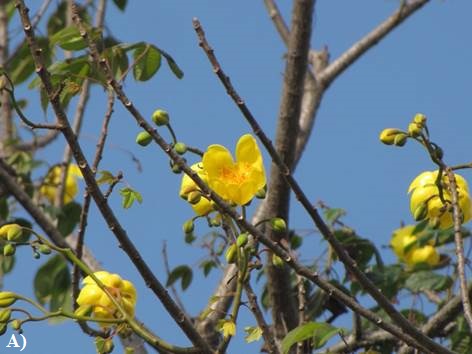
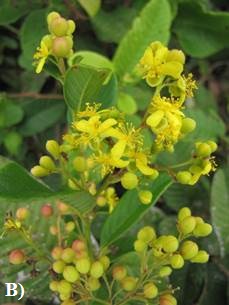
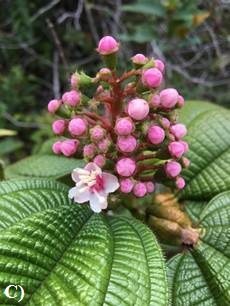
Figure 4. Some plants of the Tomogrande field station, Vichada, Colombia. A, Cochlospermum vitifolium (Bixaceae); B, Davilla nitida (Dilleniaceae); C, Miconia tococoronata (Melastomataceae). Photos Sergio Estrada-Villegas.
The most speciose orders of birds in Tomogrande are Passeriformes (88 species), Pelecaniformes (12 species), and Accipitriformes (11 species), and the most speciose families are Thyrannidae (24 species), Thraupidae (16 species), and Psittacidae (8 species). Four bird species are considered Vulnerable by the IUCN (Ramphastos vitellinus, Ramphastos tucanus, Crax alector, and Patagioenas subvinacea), and five as Near Threatened (Polystictus pectoralis, Setophaga striata, Sturnella magna, Mitu tomentosum, and Tinamus major). 180 species are considered Least Concern (Table 1). We are in the process of identifying two species from the genera Picumnus, and Progne. 37.6 % of all species have been observed in forested habitats (terra firme and flooded forests), 32.3 % in savannas, 15.9 % on forest edges, and 14.3 % close to rivers or oxbow lakes. The distinctive avifauna found in Tomogrande reflects a transition between flooded savannas of the Llanos and Amazonia. For example, it includes a diverse community of open country species typical of the Llanos (e.g., Polystictus pectoralis, Polytmus guanumbi, Emberizoides herbicola, Athene cunicularia, Sturnella magna, Chordeiles nacunda, Theristicus caudatus, and many more, Figure 5), and in the gallery forest, there are species characteristic of Amazonia (including Sclateria naevia, Thamnophilus amazonicus, Crax alector, and others). Some are residents of the forests edges (Brachygalba lugubris), other species are dependent on moriches (e.g., Orthopsittaca manilata and Icterus cayanensis), and a large number of waterbirds have also been found in the reserve, as well as short-distance migrants (e.g., Tyrannus dominicensis), long-distance boreal (e.g., Spiza americana, Bartramia longicauda, Parkesia noveboracensis, Setophaga strata, and Elanoides forficatus) and austral migrants (e.g., Tyrannus savana).
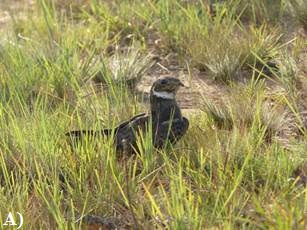
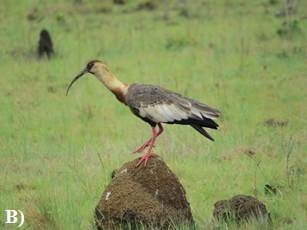
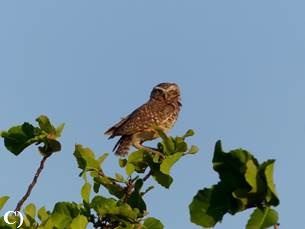
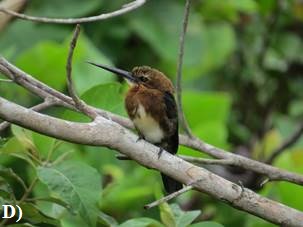
Figure 5. Some open-country birds species at the Tomogrande field station, Vichada, Colombia. A, Chordeiles nacunda; B, Theristicus caudatus; C, Athene cunicularia; D, Brachygalba lugubris. Photos A,C, Eamon C. Corbett; B, D, Nick Bayly.
The most speciose orders of mammals in Tomogrande are Chiroptera (26 species) and Carnivora (5 species), and the most speciose families are Phyllostomidae (15 species) and Emballonuridae (5 species). There are two species considered Endangered (Inia geoffrensis and Pteronura brasiliensis), two considered Vulnerable (Myrmecophaga tridactyla and Tapirus terrestris), one Data Deficient, and the remaining 42 are considered Least Concern by the IUCN (Table 1). 66% of all species have been observed in forested habitats, 23.4 % in savannas, 6.4 % on forest edges and 4.3 % next to rivers or oxbow lakes. Bats represent more than half of the recorded mammal species richness at the reserve, including uncommon and little-known species such as Eumops nanus and Promops centralis. There are also some charismatic mammals present in Tomogrande. In addition to the four species of conservation concern listed above, the reserve harbors jaguar, puma, tayra, crab-eating fox, capybara, two species of monkeys, and three artiodactyls. Tapirs can often be seen or heard in the riparian forests, especially at night.
Discussion
Tomogrande has become an important reservoir for flora and fauna in the Altillanura. For example, large-scale rubber plantations (approximately 12 000 ha) have been established just north of the reserve, and oil palm plantations are expanding in several locations in the municipality of Santa Rosalía. It has been argued that savannas worldwide can be used to avert future food shortages with large-scale agriculture (https://www.economist.com/briefing/2010/08/26/the-miracle-of-the-cerrado) and that they can help mitigate climate change via large scale afforestation (Bastin et al., 2019). However, we concur with Andrade et al. (2013) and Williams et al. (2020), that economic growth of the Altillanura should be planned not only to benefit agribusiness, but also to benefit the multiple stakeholders equitably. It is urgent to establish a regional plan to preserve large tracts of savanna and most riparian forests to avert a catastrophic loss of biodiversity (Andrade et al., 2013; Williams et al., 2020). The expansion of large-scale agribusiness in the Brazilian cerrado, a similar ecosystem to the Altillanura, has severely affected the species composition and the livelihood of stakeholders in that region (Fernandes et al., 2016). We want to prevent the same outcome in the Altillanura. Tomogrande stands out as a key area for conservation, and the scientific information we have collected confirms that the Altillanura harbors important biodiversity that needs protection.
Tomogrande makes a significant contribution to the conservation of the biodiversity of the Altillanura. We compared our species list with the one published by Peñuela et al. (2011), which summarizes the biodiversity found in other private nature reserves in Vichada. For this comparison, we first standardized the list from Peñuela et al. (2011) with the nomenclature from the Global Biodiversity Information Facility and then excluded unidentified species from their list and ours. For plants and birds, 69.3 % and 32.8 % of the species found in Tomogrande, respectively, have not been reported in other private nature reserves in Vichada. Of the 329 plant species and 260 bird species found in orther private reserves, 30.4 % and 49.2 %, respectively, are also found in Tomogrande. Additionally, more mammal species have been found in Tomogrande (47) than in other nature reserves in Vichada (28) (Peñuela et al., 2011). Of the mammal species reported by Peñuela et al. (2011), 19 are also found in Tomogrande. There are 28 mammal species only found in Tomogrande and not yet in other reserves, of which 26 are bats, reflecting the importance of increased sampling effort in studying that highly diverse group. If we compare our plant list with museum collections from the northeastern portion of the Tuparro National Park (Mendoza Cifuentes, 2007), only 5.5 % of the plant species found in Tomogrande are shared with that portion of the park. Likewise, if we compare our bird list with species reported in 201 eBird lists for the Tuparro National Park (eBird, 2021), 18.5 % of the bird species found in Tomogrande have not been reported in the Tuparro National Park, and 49.7% of the bird species found in the park are also found in Tomogrande. Concerning other private reserves in Vichada, Tomogrande is only 12.8 % of the total area reported by Peñuela et al. (2011) (19 556 ha). Similarly, Tomogrande is only 0.3 % and 15.9 %, respectively, compared to the total area of Tuparro National Park and the portion surveyed by Mendoza Cifuentes (2007). Even though all these lists were assembled with different sampling efforts, and across different spatial scales, the comparisons mentioned above clearly indicate that Tomogrande, despite its size, protects a substantial portion of the biodiversity of these major taxonomic groups in the Altillanura.
In conclusion, we present here the first species inventory for the Tomogrande nature reserve and research field station. Tomogrande not only harbors an important assemblage of plants, birds, and mammals, but it makes also a substantial contribution to the conservation of these assemblages. Our species list help fill some of the prevalent data gaps in the tropical biodiversity of the Orinoco basin (Meyer et al., 2015; Suárez-Castro et al., 2021), and the reserve contributes to the ongoing efforts to better understand and protect the habitats around and beyond the Tuparro Biosphere Reserve (Gómez-Camelo et al., 2011). We hope that the scientific information we provide can aid planning and conservation management to guarantee the sustainable use and protection of the Altillanura.
Acknowledgments
We thank research funding from Universidad de los Andes and Ecopetrol. Research has been allowed by the permits issued to Universidad de los Andes (Resolución 1177 de 2014), and research projects No. PR.6.2015.2602 y PR.6.2016.3307, and issued to SELVA (ANLA RESOLUCIÓN N° 00874). SE-V was supported by the Cullman Fellowship from the School of the Environment at Yale University and the New York Botanical Garden. Valentina Gómez-Bahamon received funding from The Rosemary Grant Award from the Society for the Study of Evolution, from the American Ornithology Society Graduate Research Award, from the Provost’s Graduate Research Award from the University of Illinois at Chicago, from the Field Museum’s H. B. Conover Fund, and from The Field Museum Armour Graduate Student Fellowship. Valentina Gómez-Bahamon and Alex E. Jahn received funding from the Fundação de Amparo á Pesquisa do Estado de São Paulo-Brazil (2012/17225-2). We also thank the valuable help of many undergraduate and graduate students that have conducted research in Tomogrande, and other visitors that have supported our work. Alcaldía de Santa Rosalía has supported our research station with solar panels and a fresh water well. Henry Baquero and Alonso Ortiz have helped us with transportation. We also thank Franciso Henao-Díaz, Andrés Montes, Mauricio Bernal, Diego Alejandro Zárate, Carolina Santos, Ivonne Natalia Vargas, Hamilton Rivas, Manuel Rodríguez and Elizabeth Bahamón for help during field work and throughout the setup of the reserve. We finally thank Ilda Becerra for her ongoing support and to AVIDA for their help with the organic farming projects conducted in Tomogrande.
References
Aldana, A. M., Villanueva, B., Cano, Á., Correa, D. F., Umaña, M. N., Casas, L. F., Cárdenas, S., Henao-Diaz, L. F. & Stevenson, P. R. (2017). Drivers of biomass stocks in Northwestern South American forests: Contributing new information on the Neotropics. Forest Ecology and Management, 389, 86-95.
https://doi.org/10.1016/j.foreco.2016.12.023
Andrade, G. I., Delgado, J., Romero, M. & Guzmán, A. (2013). La construcción de paisajes sostenibles y resilientes en intensificación agrícola de la altillanura colombiana, oportunidad que se desvanece. In M. Cárdenas & M. Rodríguez (Eds.). Desarrollo económico y adaptación al cambio climático. (Pp. 130-160). Friedrich Ebert Stiftung en Colombia & Foro Nacional Ambiental.
Arango, N., Armenteras, D., Castro, M., Gottsmann, T., Hernández, O. L., Matallana, C. L., et al. (2003). Vacíos de Conservación del Sistema de Parques Nacionales Naturales de Colombia desde una Perspectiva Ecorregional. WWF Colombia and Instituto de Investigación de Recursos Biológicos Alexander von Humboldt.
Argüello Bernal, L. S. (2012). Abundancia Relativa de Mamíferos y Aves Grandes en la Reserva Tomo Grande (Vichada). (Undergraduate thesis). Universidad de los Andes.
Bader, E., Jung, K., Kalko, E. K. V., Page, R. A., Rodríguez, R. & Sattler, T. (2015). Mobility explains the response of aerial insectivorous bats to anthropogenic habitat change in the Neotropics. Biological Conservation, 186(0), 97-106.
http://dx.doi.org/10.1016/j.biocon.2015.02.028
Bastin, J.-F., Finegold, Y., García, C., Mollicone, D., Rezende, M., Routh, D., Zohner, C. M. & Crowther, T. W. (2019). The global tree restoration potential. Science, 365(6448), 76-79.
https://doi.org/10.1126/science.aax0848
Billerman, S. M., Keeney, B. K., Rodewald, P. G. & Schulenberg, T. S. (2022). Birds of the World. Retrieved from
https://birdsoftheworld.org/bow/home
Casas, L. F. (2013). Variación de biomasa aérea y densidad de madera en bosques de tierras bajas con planos de inundación de aguas negras y aguas blancas. (Masters thesis). Universidad de los Andes.
Castiblanco, C. (2014). Scenarios of the future expansion of Oil Palm in Colombia| bimpacts generated by the biofuels sector. (PhD thesis). Universidad Javeriana.
Castiblanco, C., Etter, A. & Aide, T. M. (2013). Oil palm plantations in Colombia: a model of future expansion. Environmental Science & Policy, 27, 172-183.
https://doi.org/10.1016/j.envsci.2013.01.003
Collen, B., Ram, M., Zamin, T. & McRae, L. (2008). The tropical biodiversity data gap: Addressing disparity in global monitoring. Tropical Conservation Science, 1(2), 75-88.
https://doi.org/10.1177/194008290800100202
Correa, D. F., Álvarez, E. & Stevenson, P. R. (2015). Plant dispersal systems in Neotropical forests: availability of dispersal agents or availability of resources for constructing zoochorous fruits? Global Ecology and Biogeography, 24(2), 203-214.
https://doi.org/10.1111/geb.12248
Correa-Gómez, D. F. & Stevenson, P. R. (2010). Estructura y diversidad de bosques de galería en una sabana estacional de los llanos orientales colombianos (Reserva Tomo Grande, Vichada). (Masters thesis). Universidad de los Andes.
Cortés Capano, G., Toivonen, T., Soutullo, A. & Di Minin, E. (2019). The emergence of private land conservation in scientific literature: A review. Biological Conservation, 237, 191-199.
https://doi.org/10.1016/j.biocon.2019.07.010
Díaz, M. M., Solari, S., Aguirre, L. F., Aguiar, L. M. S. & Barquez, R. M. (2016). Clave de identificación de los murciélagos de Sudamérica. Programa de Conservación de los Murciélagos de Argentina
eBird. (2021). eBird: An online database of bird distribution and abundance [web application]. Retrieved from http://www.ebird.org
Fernandes, G. W., Coelho, M. S., Machado, R. B., Ferreira, M. E., Aguiar, L. M. d. S., Dirzo, R., Scariot, A. & Lopes, C. R. (2016). Afforestation of savannas: an impending ecological disaster. Natureza & Conservação, 14(2), 146-151.
https://doi.org/10.1016/j.ncon.2016.08.002
Forero-Medina, G. & Joppa, L. (2010). Representation of global and national conservation priorities by Colombia's protected area network. PLoS ONE, 5(10), e13210.
https://doi.org/10.1371/journal.pone.0013210
Gómez-Bahamón, V., Márquez, R., Jahn, A. E., Miyaki, C. Y., Tuero, D. T., Laverde-R., O., Restrepo, S. & Cadena, C. D. (2020). Speciation associated with shifts in migratory behavior in an avian radiation. Current Biology, 30(7), 1312-1321.e1316.
https://doi.org/10.1016/j.cub.2020.01.064
Gómez-Bahamón, V., Tuero, D. T., Castaño, M. I., Jahn, A. E., Bates, J. M. & Clark, C. J. (2020). Sonations in migratory and non-migratory Fork-tailed Flycatchers (Tyrannus savana). Integrative and Comparative Biology, 60(5), 1147-1159.
https://doi.org/10.1093/icb/icaa115
Gómez-Camelo, I. V., Gerritsen, P. & Trujillo, F. (2011). Reserva de Biósfera El Tuparro: un reto para la conservación de la Orinoquía colombiana. Ambiente y Desarrollo, 15(29), 43-64.
Góngora Blanco, D. F. (2012). Patrones de actividad y dieta de los micos maiceros (Sapajus apella) en un bosque de galería en el departamento del Vichada, Colombia. (Undegraduate thesis). Universidad de los Andes.
González-Abella, J. S., Aldana, A. M., Correa, D. F., Casas, L. F. & Stevenson, P. R. (2021). Forest Structure, Diversity and Dynamics in Terra Firme and Igapó Gallery Forests in the Colombian Orinoco Basin. Forests, 12(11), 1-16.
https://doi.org/10.3390/f12111568
Gücker, B., Boëchat, I. G. & Giani, A. (2009). Impacts of agricultural land use on ecosystem structure and whole-stream metabolism of tropical Cerrado streams. Freshwater Biology, 54(10), 2069-2085.
https://doi.org/10.1111/j.1365-2427.2008.02069.x
Hilty, S. L. & Brown, W. L. (1986). A Guide to the Birds of Colombia. Princeton University Press.
Ibáñez, C., Juste, J., López-Wilchis, R., Albuja, L. & Núñez-Garduño, A. (2002). Echolocation of three Species of sac-winged bats (Balantiopteryx). Journal of Mammalogy, 83(4), 1049-1057.
https://doi.org/10.2307/1383511
Ibáñez, C., Pérez-Jordá, J. L., Juste B., J. & Guillén, A. (1997). Los mamíferos terrestres de parque nacional de Coiba (Panamá). In S. Castroviejo & M. Velayos (Eds.). Flora y Fauna del Parque Nacional de Coiba (Panamá): Inventario preliminar. (Pp. 471-484). Agencia Español de Cooperación Internacional.
IDEAM. (2015). Estudio Nacional del Agua 2014. Bogotá.
IUCN. (2021). The IUCN Red List of Threatened Species. Version 2021-2. Retrieved from http://www.iucnredlist.org
Jung, K., Kalko, E. K. V. & Von Helversen, O. (2007). Echolocation calls in Central American emballonurid bats: signal design and call frequency alternation. Journal of Zoology, 272(2), 125-137. http://doi.org/10.1111/j.1469-7998.2006.00250.x
Jung, K., Molinari, J. & Kalko, E. K. V. (2014). Driving factors for the evolution of species-specific echolocation call design in New World free-tailed bats (Molossidae). PLoS ONE, 9(1), e85279.
https://doi.org/10.1371/journal.pone.0085279
Kraker-Castañeda, C., Santos-Moreno, A. & García-García, J. L. (2013). Riqueza de especies y actividad relativa de murciélagos insectívoros aéreos en una selva tropical y pastizales en Oaxaca, México. Mastozoología Neotropical, 20(2), 255-267.
La Sorte, F. A. & Somveille, M. (2020). Survey completeness of a global citizen-science database of bird occurrence. Ecography, 43(1), 34-43.
https://doi.org/10.1111/ecog.04632
Langholz, J., Lassoie, J. & Schelhas, J. (2000). Incentives for biological conservation: Costa Rica's private wildlife refuge program. Conservation Biology, 14(6), 1735-1743.
https://doi.org/10.1111/j.1523-1739.2000.99049.x
Lavelle, P., Rodríguez, N., Argüello, O., Bernal, J., Botero, C., Chaparro, P., et al. (2014). Soil ecosystem services and land use in the rapidly changing Orinoco River Basin of Colombia. Agriculture, Ecosystems & Environment, 185, 106-117.
https://doi.org/10.1016/j.agee.2013.12.020
MacSwiney, M. C., Clarke, F. M. & Racey, P. A. (2008). What you see is not what you get: the role of ultrasonic detectors in increasing inventory completeness in Neotropical bat assemblages. Journal of Applied Ecology, 45, 1364-1371.
https://doi.org/10.1111/j.1365-2664.2008.01531.x
Mendoza Cifuentes, H. (2007). Vegetación. In H. Villarreal-Leal & J. Maldonado-Ocampo (Eds.). Caracterización biológica del Parque Nacional Natural El Tuparro (Sector noreste), Vichada, Colombia. (Pp. 53-83). Instituto de Investigación de Recursos Biológicos Alexander von Humboldt.
Meyer, C., Kreft, H., Guralnick, R. & Jetz, W. (2015). Global priorities for an effective information basis of biodiversity distributions. Nature Communications, 6(1), 8221.
https://doi.org/10.1038/ncomms9221
Meyer, C., Weigelt, P. & Kreft, H. (2016). Multidimensional biases, gaps and uncertainties in global plant occurrence information. Ecology Letters, 19(8), 992-1006.
https://doi.org/10.1111/ele.12624
O'Farrell, M. J. & Miller, B. W. (1997). A new examination of echolocation calls of some Neotropical bats (Emballonuridae and Mormoopidae). Journal of Mammalogy, 78(3), 954-963.
https://doi.org/10.2307/1382955
O'Farrell, M. J. & Miller, B. W. (1999). Use of vocal signatures for the inventory of free-flying neotropical bats. Biotropica, 31, 507-516.
https://doi.org/10.1111/j.1744-7429.1999.tb00394.x
Ochoa, J. G., Michael, J. O. & Bruce, W. (2000). Contribution of acoustic methods to the study of insectivorous bat diversity in protected areas from northern Venezuela. Acta Chiropterologica, 2(2), 171-183.
Pegas, F. d. V. & Castley, J. G. (2016). Private reserves in Brazil: Distribution patterns, logistical challenges, and conservation contributions. Journal for Nature Conservation, 29, 14-24.
https://doi.org/10.1016/j.jnc.2015.09.007
Peñuela, L., Castro, F. & Ocampo-Peñuela, N. (2011). Las reservas naturales del nodo Orinoquia en su rol de conservación de la biodiversidad. Bogotá: Fundación Horizonte Verde y Resnatur.
Peñuela, L. & Fernández, A. P. (2010). La ganadería ligada a procesos de conservación en la sabana inundable de la Orinoquia. Orinoquia, 14(1), 5-17.
Power, A. G. (2010). Ecosystem services and agriculture: tradeoffs and synergies. Philosophical Transactions of the Royal Society B: Biological Sciences, 365(1554), 2959-2971.
https://doi.org/10.1098/rstb.2010.0143
Rangel-Ch., J. O. (2015). La biodiversidad de Colombia: significado y distribución regional. Revista de la Academia Colombiana de Ciencias Exactas, Físicas y Naturales, 39, 176-200.
https://doi.org/10.18257/raccefyn.136
Restall, R., Rodner, C. & Lentino, M. (2006). Birds of Northern South America: An Identification Guide (Vol. 2). Yale University Press.
Rippstein, G., Escobar, G. & Motta, F. (2001). Agroecología y biodiversidad de las sabanas en los Llanos Orientales de Colombia. CIAT.
Romero-Ruiz, M. H., Flantua, S. G. A., Tansey, K. & Berrío, J. C. (2012). Landscape transformations in savannas of northern South America: Land use/cover changes since 1987 in the Llanos Orientales of Colombia. Applied Geography, 32(2), 766-776.
https://doi.org/10.1016/j.apgeog.2011.08.010
Rydell, J., Arita, H. T., Santos, M. & Granados, J. (2002). Acoustic identification of insectivorous bats (order Chiroptera) of Yucatan, Mexico. Journal of Zoology, 257(1), 27-36.
https://doi.org/10.1017/S0952836902000626
Sánchez Medina, W. N. (2017). Patrones de actividad y de alimentación del mono maicero, Sapajus apella (Primates: Cebidae), en un bosque de galería en la Reserva Tomo Grande (Vichada, Colombia). (Undergraduate thesis). Universidad de Antioquia.
Santamaría Gómez, M., Roa Vargas, E., Del Río, J. S., Antelo Albertos, R., Rodríguez Cruz, H., Cruz Cárdenas, G. & Roa López, N. (2019). Ordenar para conservar. Guía para planificación de las áreas bajo protección privada de la Orinoquia. Resnatur, Fundación Cunaguaro, Corporación Ambiental La Pedregoza, Fundación Palmarito, Parques Nacionales Naturales de Colombia y Asociación de Becarios de Casanare ABC.
Sarmiento, G. (2013). The ecology of neotropical savannas. Harvard University Press.
Stevenson, P. R. (2016). Neotropical primate communities: Effects of disturbance, resource production and forest type heterogeneity. American Journal of Primatology, 78(4), 391-401.
https://doi.org/10.1002/ajp.22518
Stevenson, P. R., Aldana, A. M., Cárdenas, S. & Negret, P. J. (2018). Flooding and soil composition determine beta diversity of lowland forests in Northern South America. Biotropica, 50(4), 568-577.
https://doi.org/10.1111/btp.12541
Suárez-Castro, A. F., Ramírez-Chaves, H. E., Noguera-Urbano, E. A., Velásquez-Tibatá, J., González-Maya, J. F. & Lizcano, D. J. (2021). Vacíos de información espacial sobre la riqueza de mamíferos terrestres continentales de Colombia. Caldasia, 43(2).
https://doi.org/10.15446/caldasia.v43n2.85443
Surlykke, A. & Kalko, E. K. V. (2008). Echolocating bats cry out loud to detect their prey. PLoS ONE, 3(4), e2036.
http://dx.plos.org/10.1371%2Fjournal.pone.0002036
ter Steege, H., Henkel, T. W., Helal, N., Marimon, B. S., Marimon-Junior, B. H., Huth, A., et al. (2019). Rarity of monodominance in hyperdiverse Amazonian forests. Scientific Reports, 9(1), 13822.
https://doi.org/10.1038/s41598-019-50323-9
Umaña, M. N., Correa, D. F., Cano, Á., Casas, L. F., Cárdenas, S., Villanueva, B. & Stevenson, P. (2018). Diversity of dispersal systems in igapó forests: An analysis of local tree diversity, species turnover, and dispersal systems. In R. W. Myster (Ed.), Igapó (Black-water Flooded Forests) of the Amazon Basin. (Pp. 23-35). Springer International Publishing.
Vargas, L. E. P., Laurance, W. F., Clements, G. R. & Edwards, W. (2015). The impacts of oil palm agriculture on Colombia's biodiversity: What we know and still need to know. Tropical Conservation Science, 8(3), 828-845.
https://doi.org/10.1177/194008291500800317
Veldman, J. W., Buisson, E., Durigan, G., Fernandes, G. W., Le Stradic, S., Mahy, G., et al. (2015). Toward an old-growth concept for grasslands, savannas, and woodlands. Frontiers in Ecology and the Environment, 13(3), 154-162.
https://doi.org/10.1890/140270
Williams, B. A., Grantham, H. S., Watson, J. E. M., Alvarez, S. J., Simmonds, J. S., Rogéliz, C. A., et al. (2020). Minimising the loss of biodiversity and ecosystem services in an intact landscape under risk of rapid agricultural development. Environmental Research Letters, 15(1), 014001.
https://doi.org/10.1088/1748-9326/ab5ff7
1 Yale School of the Environment, Yale University. New Haven, CT, USA.
2 The New York Botanical Garden, Bronx. NY, USA.
3 Smithsonian Tropical Research Institute. Balboa, Panamá.
4 Reserva biológica y estación científica Tomogrande, vereda Nazareth, Santa Rosalía, Vichada, Colombia.
5 Departamento de Ciencias Biológicas, Universidad de los Andes. Bogotá, Colombia.
6 Centre for Biodiversity and Conservation Science CBCS, The University of Queensland. Brisbane, Australia.
7 Grupo Mutis, Vicerrectoría, Universidad del Rosario. Bogotá, Colombia.
8 Fundación Natura. Bogotá, Colombia
9 Fundación Humedales. Bogotá, Colombia.
10 Department of Biological Sciences, University of Illinois. Chicago, IL, USA.
11 SELVA: Investigación para la Conservación en el Neotrópico. Bogotá, Colombia.
12 Negaunee Integrative Research Center, Field Museum of Natural History. Chicago, IL, USA.
13 Environmental Resilience Institute, Indiana University. Bloomington, IN, USA
14 Museum of Natural Science and Department of Biological Sciences, Louisiana State University. Baton Rouge, LA, USA
15 Independent researcher.
*Autor para correspondencia
Referencias
American forests: Contributing new information on the Neotropics. Forest Ecology and Management, 389, 86-95. https://doi.org/10.1016/j.foreco.2016.12.023
Andrade, G. I., Delgado, J., Romero, M. & Guzmán, A. (2013). La construcción de paisajes sostenibles y resilientes en intensificación agrícola de la altillanura colombiana, oportunidad que se desvanece. In M. Cárdenas & M. Rodríguez (Eds.). Desarrollo económico y adaptación al cambio climático. (Pp. 130-160). Friedrich Ebert Stiftung en Colombia & Foro Nacional Ambiental.
Arango, N., Armenteras, D., Castro, M., Gottsmann, T., Hernández, O. L., Matallana, C. L., et al. (2003). Vacíos de Conservación del Sistema de Parques Nacionales Naturales de Colombia desde una Perspectiva Ecorregional. WWF Colombia and Instituto de Investigación de Recursos Biológicos Alexander von Humboldt.
Argüello Bernal, L. S. (2012). Abundancia Relativa de Mamíferos y Aves Grandes en la Reserva Tomo Grande (Vichada). (Undergraduate thesis). Universidad de los Andes.
Bader, E., Jung, K., Kalko, E. K. V., Page, R. A., Rodríguez, R. & Sattler, T. (2015). Mobility explains the response of aerial insectivorous bats to anthropogenic habitat change in the Neotropics. Biological Conservation, 186(0), 97-106. http://dx.doi.org/10.1016/j.biocon.2015.02.028
Bastin, J.-F., Finegold, Y., García, C., Mollicone, D., Rezende, M., Routh, D., Zohner, C. M. & Crowther, T. W. (2019). The global tree restoration potential. Science, 365(6448), 76-79. https://doi.org/10.1126/science.aax0848
Billerman, S. M., Keeney, B. K., Rodewald, P. G. & Schulenberg, T. S. (2022). Birds of the World. Retrieved from https://birdsoftheworld.org/bow/home
Casas, L. F. (2013). Variación de biomasa aérea y densidad de madera en bosques de tierras bajas con planos de inundación de aguas negras y aguas blancas. (Masters thesis). Universidad de los Andes.
Castiblanco, C. (2014). Scenarios of the future expansion of Oil Palm in Colombia| bimpacts generated by the biofuels sector. (PhD thesis). Universidad Javeriana.
Castiblanco, C., Etter, A. & Aide, T. M. (2013). Oil palm plantations in Colombia: a model of future expansion. Environmental Science & Policy, 27, 172-183. https://doi.org/10.1016/j.envsci.2013.01.003
Collen, B., Ram, M., Zamin, T. & McRae, L. (2008). The tropical biodiversity data gap: Addressing disparity in global monitoring. Tropical Conservation Science, 1(2), 75-88. https://doi.org/10.1177/194008290800100202
Correa, D. F., Álvarez, E. & Stevenson, P. R. (2015). Plant dispersal systems in Neotropical forests: availability of dispersal agents or availability of resources for constructing zoochorous fruits? Global Ecology and Biogeography, 24(2), 203-214. https://doi.org/10.1111/geb.12248
Correa-Gómez, D. F. & Stevenson, P. R. (2010). Estructura y diversidad de bosques de galería en una sabana estacional de los llanos orientales colombianos (Reserva Tomo Grande, Vichada). (Masters thesis). Universidad de los Andes.
Cortés Capano, G., Toivonen, T., Soutullo, A. & Di Minin, E. (2019). The emergence of private land conservation in scientific literature: A review. Biological Conservation, 237, 191-199. https://doi.org/10.1016/j.biocon.2019.07.010
Díaz, M. M., Solari, S., Aguirre, L. F., Aguiar, L. M. S. & Barquez, R. M. (2016). Clave de identificación de los murciélagos de Sudamérica. Programa de Conservación de los Murciélagos de Argentina
eBird. (2021). eBird: An online database of bird distribution and abundance [web application]. http://www.ebird.org
Fernandes, G. W., Coelho, M. S., Machado, R. B., Ferreira, M. E., Aguiar, L. M. d. S., Dirzo, R., Scariot, A. & Lopes, C. R. (2016). Afforestation of savannas: an impending ecological disaster. Natureza & Conservação, 14(2), 146-151. https://doi.org/10.1016/j.ncon.2016.08.002
Forero-Medina, G. & Joppa, L. (2010). Representation of global and national conservation priorities by Colombia's protected area network. PLoS ONE, 5(10), e13210. https://doi.org/10.1371/journal.pone.0013210
Gómez-Bahamón, V., Márquez, R., Jahn, A. E., Miyaki, C. Y., Tuero, D. T., Laverde-R., O., Restrepo, S. & Cadena, C. D. (2020). Speciation associated with shifts in migratory behavior in an avian radiation. Current Biology, 30(7), 1312-1321.e1316. https://doi.org/10.1016/j.cub.2020.01.064
Gómez-Bahamón, V., Tuero, D. T., Castaño, M. I., Jahn, A. E., Bates, J. M. & Clark, C. J. (2020). Sonations in migratory and non-migratory Fork-tailed Flycatchers (Tyrannus savana). Integrative and Comparative Biology, 60(5), 1147-1159. https://doi.org/10.1093/icb/icaa115
Gómez-Camelo, I. V., Gerritsen, P. & Trujillo, F. (2011). Reserva de Biósfera El Tuparro: un reto para la conservación de la Orinoquía colombiana. Ambiente y Desarrollo, 15(29), 43-64.
Góngora Blanco, D. F. (2012). Patrones de actividad y dieta de los micos maiceros (Sapajus apella) en un bosque de galería en el departamento del Vichada, Colombia. (Undegraduate thesis). Universidad de los Andes.
González-Abella, J. S., Aldana, A. M., Correa, D. F., Casas, L. F. & Stevenson, P. R. (2021). Forest Structure, Diversity and Dynamics in Terra Firme and Igapó Gallery Forests in the Colombian Orinoco Basin. Forests, 12(11), 1-16. https://doi.org/10.3390/f12111568
Gücker, B., Boëchat, I. G. & Giani, A. (2009). Impacts of agricultural land use on ecosystem structure and whole-stream metabolism of tropical Cerrado streams. Freshwater Biology, 54(10), 2069-2085. https://doi.org/10.1111/j.1365-2427.2008.02069.x
Hilty, S. L. & Brown, W. L. (1986). A Guide to the Birds of Colombia. Princeton University Press.
Ibáñez, C., Juste, J., López-Wilchis, R., Albuja, L. & Núñez-Garduño, A. (2002). Echolocation of three Species of sac-winged bats (Balantiopteryx). Journal of Mammalogy, 83(4), 1049-1057. https://doi.org/10.2307/1383511
Ibáñez, C., Pérez-Jordá, J. L., Juste B., J. & Guillén, A. (1997). Los mamíferos terrestres de parque nacional de Coiba (Panamá). In S. Castroviejo & M. Velayos (Eds.). Flora y Fauna del Parque Nacional de Coiba (Panamá): Inventario preliminar. (Pp. 471-484). Agencia Español de Cooperación Internacional.
IDEAM. (2015). Estudio Nacional del Agua 2014. Bogotá.
IUCN. (2021). The IUCN Red List of Threatened Species. Version 2021-2. https://www.iucnredlist.org
Jung, K., Kalko, E. K. V. & Von Helversen, O. (2007). Echolocation calls in Central American emballonurid bats: signal design and call frequency alternation. Journal of Zoology, 272(2), 125-137. http://doi.org/10.1111/j.1469-7998.2006.00250.x
Jung, K., Molinari, J. & Kalko, E. K. V. (2014). Driving factors for the evolution of species-specific echolocation call design in New World free-tailed bats (Molossidae). PLoS ONE, 9(1), e85279. https://doi.org/10.1371/journal.pone.0085279
Kraker-Castañeda, C., Santos-Moreno, A. & García-García, J. L. (2013). Riqueza de especies y actividad relativa de murciélagos insectívoros aéreos en una selva tropical y pastizales en Oaxaca, México. Mastozoología Neotropical, 20(2), 255-267.
La Sorte, F. A. & Somveille, M. (2020). Survey completeness of a global citizen-science database of bird occurrence. Ecography, 43(1), 34-43. https://doi.org/10.1111/ecog.04632
Langholz, J., Lassoie, J. & Schelhas, J. (2000). Incentives for biological conservation: Costa Rica's private wildlife refuge program. Conservation Biology, 14(6), 1735-1743. https://doi.org/10.1111/j.1523-1739.2000.99049.x
Lavelle, P., Rodríguez, N., Argüello, O., Bernal, J., Botero, C., Chaparro, P., et al. (2014). Soil ecosystem services and land use in the rapidly changing Orinoco River Basin of Colombia. Agriculture, Ecosystems & Environment, 185, 106-117. https://doi.org/10.1016/j.agee.2013.12.020
MacSwiney, M. C., Clarke, F. M. & Racey, P. A. (2008). What you see is not what you get: the role of ultrasonic detectors in increasing inventory completeness in Neotropical bat assemblages. Journal of Applied Ecology, 45, 1364-1371. https://doi.org/10.1111/j.1365-2664.2008.01531.x
Mendoza Cifuentes, H. (2007). Vegetación. In H. Villarreal-Leal & J. Maldonado-Ocampo (Eds.). Caracterización biológica del Parque Nacional Natural El Tuparro (Sector noreste), Vichada, Colombia. (Pp. 53-83). Instituto de Investigación de Recursos Biológicos Alexander von Humboldt.
Meyer, C., Kreft, H., Guralnick, R. & Jetz, W. (2015). Global priorities for an effective information basis of biodiversity distributions. Nature Communications, 6(1), 8221. https://doi.org/10.1038/ncomms9221
Meyer, C., Weigelt, P. & Kreft, H. (2016). Multidimensional biases, gaps and uncertainties in global plant occurrence information. Ecology Letters, 19(8), 992-1006. https://doi.org/10.1111/ele.12624
O'Farrell, M. J. & Miller, B. W. (1997). A new examination of echolocation calls of some Neotropical bats (Emballonuridae and Mormoopidae). Journal of Mammalogy, 78(3), 954-963. https://doi.org/10.2307/1382955
O'Farrell, M. J. & Miller, B. W. (1999). Use of vocal signatures for the inventory of free-flying neotropical bats. Biotropica, 31, 507-516. https://doi.org/10.1111/j.1744-7429.1999.tb00394.x
Ochoa, J. G., Michael, J. O. & Bruce, W. (2000). Contribution of acoustic methods to the study of insectivorous bat diversity in protected areas from northern Venezuela. Acta Chiropterologica, 2(2), 171-183.
Pegas, F. d. V. & Castley, J. G. (2016). Private reserves in Brazil: Distribution patterns, logistical challenges, and conservation contributions. Journal for Nature Conservation, 29, 14-24. https://doi.org/10.1016/j.jnc.2015.09.007
Peñuela, L., Castro, F. & Ocampo-Peñuela, N. (2011). Las reservas naturales del nodo Orinoquia en su rol de conservación de la biodiversidad. Bogotá: Fundación Horizonte Verde y Resnatur.
Peñuela, L. & Fernández, A. P. (2010). La ganadería ligada a procesos de conservación en la sabana inundable de la Orinoquia. Orinoquia, 14(1), 5-17.
Power, A. G. (2010). Ecosystem services and agriculture: tradeoffs and synergies. Philosophical Transactions of the Royal Society B: Biological Sciences, 365(1554), 2959-2971. https://doi.org/10.1098/rstb.2010.0143
Rangel-Ch., J. O. (2015). La biodiversidad de Colombia: significado y distribución regional. Revista de la Academia Colombiana de Ciencias Exactas, Físicas y Naturales, 39, 176-200. https://doi.org/10.18257/raccefyn.136
Restall, R., Rodner, C. & Lentino, M. (2006). Birds of Northern South America: An Identification Guide (Vol. 2). Yale University Press.
Rippstein, G., Escobar, G. & Motta, F. (2001). Agroecología y biodiversidad de las sabanas en los Llanos Orientales de Colombia. CIAT.
Romero-Ruiz, M. H., Flantua, S. G. A., Tansey, K. & Berrío, J. C. (2012). Landscape transformations in savannas of northern South America: Land use/cover changes since 1987 in the Llanos Orientales of Colombia. Applied Geography, 32(2), 766-776. https://doi.org/10.1016/j.apgeog.2011.08.010
Rydell, J., Arita, H. T., Santos, M. & Granados, J. (2002). Acoustic identification of insectivorous bats (order Chiroptera) of Yucatan, Mexico. Journal of Zoology, 257(1), 27-36. https://doi.org/10.1017/S0952836902000626
Sánchez Medina, W. N. (2017). Patrones de actividad y de alimentación del mono maicero, Sapajus apella (Primates: Cebidae), en un bosque de galería en la Reserva Tomo Grande (Vichada, Colombia). (Undergraduate thesis). Universidad de Antioquia.
Santamaría Gómez, M., Roa Vargas, E., Del Río, J. S., Antelo Albertos, R., Rodríguez Cruz, H., Cruz Cárdenas, G. & Roa López, N. (2019). Ordenar para conservar. Guía para planificación de las áreas bajo protección privada de la Orinoquia. Resnatur, Fundación Cunaguaro, Corporación Ambiental La Pedregoza, Fundación Palmarito, Parques Nacionales Naturales de Colombia y Asociación de Becarios de Casanare ABC.
Sarmiento, G. (2013). The ecology of neotropical savannas. Harvard University Press.
Stevenson, P. R. (2016). Neotropical primate communities: Effects of disturbance, resource production and forest type heterogeneity. American Journal of Primatology, 78(4), 391-401. https://doi.org/10.1002/ajp.22518
Stevenson, P. R., Aldana, A. M., Cárdenas, S. & Negret, P. J. (2018). Flooding and soil composition determine beta diversity of lowland forests in Northern South America. Biotropica, 50(4), 568-577. https://doi.org/10.1111/btp.12541
Suárez-Castro, A. F., Ramírez-Chaves, H. E., Noguera-Urbano, E. A., Velásquez-Tibatá, J., González-Maya, J. F. & Lizcano, D. J. (2021). Vacíos de información espacial sobre la riqueza de mamíferos terrestres continentales de Colombia. Caldasia, 43(2). https://doi.org/10.15446/caldasia.v43n2.85443
Surlykke, A. & Kalko, E. K. V. (2008). Echolocating bats cry out loud to detect their prey. PLoS ONE, 3(4), e2036. http://dx.plos.org/10.1371%2Fjournal.pone.0002036
ter Steege, H., Henkel, T. W., Helal, N., Marimon, B. S., Marimon-Junior, B. H., Huth, A., et al. (2019). Rarity of monodominance in hyperdiverse Amazonian forests. Scientific Reports, 9(1), 13822. https://doi.org/10.1038/s41598-019-50323-9
Umaña, M. N., Correa, D. F., Cano, Á., Casas, L. F., Cárdenas, S., Villanueva, B. & Stevenson, P. (2018). Diversity of dispersal systems in igapó forests: An analysis of local tree diversity, species turnover, and dispersal systems. In R. W. Myster (Ed.), Igapó (Black-water Flooded Forests) of the Amazon Basin. (Pp. 23-35). Springer International Publishing.
Vargas, L. E. P., Laurance, W. F., Clements, G. R. & Edwards, W. (2015). The impacts of oil palm agriculture on Colombia's biodiversity: What we know and still need to know. Tropical Conservation Science, 8(3), 828-845. https://doi.org/10.1177/194008291500800317
Veldman, J. W., Buisson, E., Durigan, G., Fernandes, G. W., Le Stradic, S., Mahy, G., et al. (2015). Toward an old-growth concept for grasslands, savannas, and woodlands. Frontiers in Ecology and the Environment, 13(3), 154-162. https://doi.org/10.1890/140270
Williams, B. A., Grantham, H. S., Watson, J. E. M., Alvarez, S. J., Simmonds, J. S., Rogéliz, C. A., et al. (2020). Minimising the loss of biodiversity and ecosystem services in an intact landscape under risk of rapid agricultural development. Environmental Research Letters, 15(1), 014001. https://doi.org/10.1088/1748-9326/ab5ff7
Cómo citar

Esta obra está bajo una licencia internacional Creative Commons Atribución-NoComercial-SinDerivadas 4.0.
Derechos de autor 2022 Instituto de Investigación de Recursos Biológicos Alexander Von Humboldt

